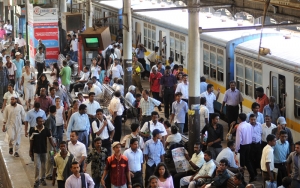
Tuesday, 2nd September 2014
Lakshman I.Keerthisinghe LLB, LLM. MPhil, Attorney-at-Law
 “Any fool can make things bigger, more complex, and more violent. It takes a touch of genius—and a lot of courage—to move in the opposite direction.”
“Any fool can make things bigger, more complex, and more violent. It takes a touch of genius—and a lot of courage—to move in the opposite direction.”
- Albert Einstein
“Vulnerability has multiple causes and consequences. Reducing vulnerability is a key ingredient in any agenda for improving human development. But if we are to succeed in reducing vulnerability, we need to approach it from a broad systemic perspective.”
- Nobel Laureate Joseph Stiglitz
The 2014 Human Development Report is the latest in the series of global Human Development Reports published by UNDP since 1990 as independent, empirically grounded analyses of major development issues, trends and policies.
Additional resources related to the 2014 Human Development Report include complete editions or summaries of the Report in more than 20 languages, a collection of papers commissioned for the 2014 Report, interactive maps and databases of national human development indicators, full explanations of the sources and methodologies employed in the Report’s human development indices, country profiles and other background materials as well as previous global, regional and national Human Development Reports.
More than 200 million people a year, most of them in developing countries, are affected by natural disasters. The number of people displaced by conflict or persecution—45 million by the end of 2012—is the highest in 18 years. Economic setbacks threaten to undermine social gains even in advanced industrialized societies. And in addition to bringing many benefits, globalization has also conveyed new vulnerabilities: Shocks in one part of the world can spread rapidly, impacting people’s lives everywhere.
Social cohesion

The Report highlights the need for both promoting people’s choices and protecting human development achievements. It stresses the importance of identifying and addressing persistent vulnerabilities by building resilience and enhancing people’s capability to cope with shocks—financial, natural or otherwise.
Although almost everyone is likely to feel vulnerable at some point in life, some individuals and groups are systematically worse off. Almost 1.5 billion people are multidimensionally poor, with overlapping deprivations in health, education and living standards. And close to 800 million people are vulnerable to falling back into poverty when setbacks occur.
This Report focuses on the people at greatest risk and on key underlying drivers of vulnerability. It analyses structural causes—social marginalization, position in society and insufficient public services—and pays attention to the different vulnerabilities faced at different stages of the life cycle. Hazards and shocks will inevitably occur, but measures can be taken to contain how far these events reduce human development.
This Report argues that most shocks and setbacks can be overcome with the right policies and a stronger commitment to social cohesion. Early detection mechanisms and modest investments at the right time can often considerably reduce vulnerability and build resilience.
A human development approach is therefore incomplete unless it incorporates vulnerability and resilience into the analysis. Identifying and targeting vulnerable groups, reducing inequality and addressing structural vulnerabilities are essential to yield robust and sustainable human progress across generations.
By addressing vulnerabilities, all people may share in development progress, and human development will become increasingly equitable and sustainable. “Vulnerability has multiple causes and consequences. Reducing vulnerability is a key ingredient in any agenda for improving human development. But if we are to succeed in reducing vulnerability, we need to approach it from a broad systemic perspective” as stated by Nobel Laureate Joseph Stiglitz,
Human resilience is about removing the barriers that hold people back in their freedom to act. It is also about enabling disadvantaged and excluded groups to express their concerns, to be heard and to be active agents in shaping their destiny.
Despite great and varied progress, vulnerable people and vulnerable groups remain—none more so than the disabled.
The United Nations estimates that more than a billion people live with some form of disability, and they are disproportionately represented among the worlds’ poorest. Pope Francis I has stated that “Human rights are violated not only by terrorism, repression or assassination, but also by unfair economic structures that create huge inequalities.”
It is noteworthy that Sri Lanka ranks above all other South Asian nations in UN Human Development Index. Sri Lanka has been placed in the 73rd position in the United Nations Human Development Index for 2014.According to the index which was released on July 24, 2014 in Tokyo, Sri Lanka is ranked above all South Asian nations.
Human Development Index
The Human Development Index (HDI), a measure derived from life expectancy, education and income levels, barely grew from 0.700 in 2012 to 0.702 in 2013. The HDR covers 187 countries across the world and is published annually by the United Nations Development Program (UNDP). In the current report, the top five countries ranked in terms of the HDI are Norway, Australia, Switzerland, Netherlands and the US.
The bottom five in this ranking are Niger, Democratic Republic of Congo, Central African Republic, Chad and Sierra Leone. India is ranked at 135, among the ‘medium development’ countries like Egypt, South Africa, Mongolia, Philippines and Indonesia. Among India’s neighbours, Bhutan at 136 and Bangladesh and Maldives at 103 too figure in this category. Pakistan (ranked 146) and Nepal (145) are in the ‘low development’ category, while Sri Lanka (73) is in the ‘high development’ category. China occupies the 91st place with Thailand at 89th place.
The HDR notes that over 200 million people are affected by natural disasters and 45 million, the largest number in 18 years, were displaced by conflicts at the end of 2012. These factors also contributed to denting the improvement in human development.
The Report titled ‘Sustaining Human Progress: Reducing Vulnerability and Building Resilience’ indicates that Sri Lanka has progressively improved in human development over the years. Sri Lanka’s Human Development Index (HDI) has progressively increased up to 0.750 in 2014 compared to 0.513 in 1980.
The country, up by two notches from last year’s rank, is placed at the 73rd position, the highest among the nine South Asian countries, in the index. The country, up by two notches from last year’s rank, is placed at the 73rd position, the highest among the nine South Asian countries, in the index that is a composite national measure of health, education, and income for 187 countries.
Colonial history
The average HDI value for the Asia region, at 0.588, is below the world average of 0.702 and only Sri Lanka in the South Asian region is above the average. Sri Lanka, which shares a colonial history similar to that of India and the rest of the subcontinent, achieved nearly universal education and health care despite years of militancy and war,” the 2014 report said.
“The report has considered Sri Lanka’s favourable social indicators of literacy, life expectancy and year of schooling to place the country in the High Human Development group. Sri Lanka has performed far better in human development than in income alone as seen in the large difference in the Gross National Income per capita and HDI rankings, the report noted. Sri Lanka’s Gross National Income per capita ranked 103 while the HDI ranked 73.
South Asia has the largest multidimensionally poor population, with more than 800 million poor and over 270 million near-poor - that is, more than 71 per cent of its population. This makes the region home to 56 per cent of the world’s poor and more than 35 per cent of the world’s near-poor. “Staggering rates of poverty, high inequality and frequent natural disasters and crises threaten the progress of human development in Asia and the Pacific. Addressing these challenges requires a host of initiatives, including universal provision of social services and a strong system of social security benefits,” the 2014 Human Development Report said. It takes the view that vulnerability threatens human development and, unless it is systematically addressed, progress will be neither equitable nor sustainable.
The 2014 HDR highlights the need for both promoting people’s choices and protecting human development achievements and offers a fresh perspective on what makes people vulnerable, and proposes ways to strengthen resilience. HDR 2014 introduces a gender development index (GDI) for the first time, which compares the HDI calculated separately for women and men among 148 countries. Worldwide, female HDI values are eight per cent lower than those for males, with large variations between countries. Sri Lanka ranks 66 in the GDI with an HDI of 0.720 for women and 0.750 for men.
Although the HDI gap is relatively small on average, the disparity between genders in the estimated gross national income per capita is very high: per capita income for men at the global level is more than double that for women. This year’s report points to a slowdown in human development growth across all regions noting that threats such as financial crises, fluctuations in food prices, natural disasters and violent conflict significantly impede progress.
In conclusion it must be stated that the policies followed by the present regime have borne fruit and whatever the disgruntled misguided critics may utter, it is an undisputable fact that Sri Lanka has achieved the top position in the South Asian region in both Human Development Index and the Rule of Law index, which are prepared by independent internationally recognized bodies.
From : http://www.dailynews.lk/?q=features/two-indexes-two-top-scores-lanka




